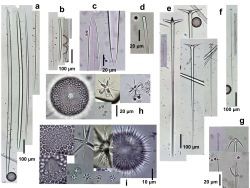cream
cinnamon-tan
massive
crumbly
Colombia
Geodia papyracea
Description: Irregular, lobed masses, some 10-15 or more in maximum size. Surface is even, microrugose, with sparse depressions where oscular plates are located. Color cream, clearer in shaded parts, brownish in more exposed parts; internal tissue cream. Consistency crumbly, with the cortex rather easily broken and peeled off. We have not yet examined the architecture of the skeleton, and the reader is referred to Silva et al (2004) and Cárdenas (2009), for recent redescriptions of the species. Megasclere spicules in three types: (1) Oxea I, slightly curved, usually hastate, with acute or slightly blunt ends, the smaller ones thin and fusiform, 560-1275 µm long and 6.3-30 µm wide. (2) Oxea and styles II, slightly curved, the oxea fusiform, the styles hastate, 210-380 µm long and 2.3-17 µm wide. (3) Triaenes in three types: Plagiotriaenes, the most common, slender to stout, with generally short and acute clades, 17-100 µm long and 7.5-21 µm wide at the base; rhabds also stout, acute at the ends, 410-1075 µm long and 8.8-30 µm wide at the base. Anatrianes, thin and slender, with relatively small clades, 2.5-10.5 µm long and up to 5 µm wide at the base; rhabds thin and long, acute, 350-610 µm long and 2-7 µm wide. Rare mesoprotriaenes, with short (up to 22) clads and long (860 x 6 µm) rhabds. Microscleres in two basic types: (1) Sterrasters, round, relatively large, 62.5-80 µm in diameter, with small spined rosettes (up to about 4 µm in diameter), which have warts over the spines (rather difficult to observe in light microscopy); developmental stages of sterrasters are smaller balls surrounded by thin needles. (2) Asters in three categories (difficult to discern under light microscopy), with spined rays; large oxyasters, one class with up to 9 slender rays, and the other with stouter and more numerous (up to 20) rays, both reaching up to 32.5-35 µm in total diameter; smaller strongyl- or oxyasters, 6.3-7.5 µm in total diameter.
Notes: This species is found in mangrove stilt roots, often overgrown by or overgrowing other organisms. Could be confused with other Geodia inhabiting the same environment (not pictured here), but is readily distinguished by its crumbly consistency. Its smaller oxea I and the relatively small size and additional microspination (warts) of the sterraster rosettes, plus the presence of anatriaenes helps distinguish it from the other Geodia pictured here. For detailed redescriptions see Silva et al. (2004) and Cárdenas (2009).
Author Reference: Hechtel, 1965
Link: World Porifera Database

![<i>Geodia papyracea</i> <br />[Colombia, Islas de San Bernardo]](mini/00115/01912.jpg)
